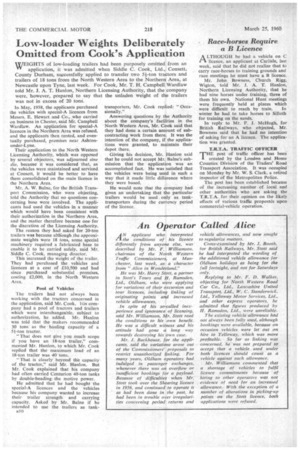Low-loader Weights Deliberately Omitted from Cook's Application
Page 44

If you've noticed an error in this article please click here to report it so we can fix it.
WEIGHTS of low-loading trailers had been purposely omitted from an application, it was admitted when Siddle C. Cook, Ltd., Consett, County Durham, successfully applied to transfer two 51-ton tractors and trailers of 18 tons from the North Western Area to the Northern Area, at Newcastle upon Tyne, last week. For Cook, Mr. T. H. Campbell Wardlaw told Mr. J. A. T. Hanlon, Northern Licensing Authority, that the company were, however, prepared to say that the unladen weight of the trailers was not in excess of 20 tons.
In May, 1958, the applicants purchased the vehicles with special-A licences from Messrs. E. Hewart and Co., who carried on business in Chester, said Mr. Campbell Wardlaw. An application for special-A licences in the Northern Area was refused, and the applicants then rented, and eventually purchased, premises near Ashtonunder-Lyne.
Their application to the North Western Licensing Authority, which was opposed by several objectors, was adjourned sine die, because it was considered that, as the vehicles were maintained and serviced at Consett, it would be better to have them consolidated on the main licence in the Northern Area, Mr. A. W. Balne, for the British Transport Commission, who were objecting, told the Authority that no questions concerning base were involved. The applicants had used the vehicles in a manner which would have been consistent with their authorization in the Northern Area, and the matter therefore became one for the discretion of the Licensing Authority.
The reason they had asked for 20-ton trailers was because although the approximate weights were 18 tons, some special machinery required a fabricated base to enable it to be carried safely, said Mr. Siddle C. Cook, managing director.
This increased the weight of the trailer. They had purchased the vehicles and licences at a cost of £10,500 and had since purchased substantial premises, costing 12,000, in the North Western Area.
Pool of Vehicles The trailers had not always been working with the tractors concerned in the application, said Mr. Cook, His company had a pool of tractors and trailers which were interchangeable, subject to authorization, he added. Mr. Hanlon was told that the makers recommended 30 tons" as the hauling capacity of a 5+-ton tractor.
"That does not give you much scope if you have an 18-ton trailer," commented Mr. Hanlon. to which Mr. Cook replied that the maximum load of an I8-ton trailer was 40 tons.
"That is clearly beyond the capacity of the tractor," said Mr. Hanlon. But Mr. Cook explained that his company had often carried Centurion 40-ton tanks by double-heading the motive power.
He admitted that he had bought the special-A licences and the vehicles because his company wanted to increase their trailer strength and carrying capacity. Asked by Mr. Babe if he intended to use the trailers as tank transporters, Mr. Cook replied: "Occasionally."
Answering questions by the Authority about the company's facilities in the North Western Area, Mr. Cook said that they had done a certain amount of subcontracting work from there. It was the intention of the company, if the applications were granted, to maintain their depot there.
Giving his decision, Mr. Hanlon said that he could not accept Mr. Balne's submission that the application was an accomplished fact. He was satisfied that the vehicles were being used in such a way that it made little difference where they were based.
He would ncite that the company had given an undertaking that the particular trailers would be used only as tank transporters during the currency period of the licence.




















































































































